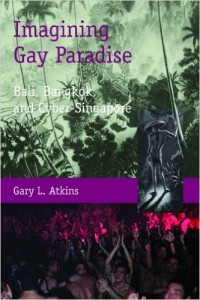 Imagining Gay Paradise: Bali, Bangkok, and Cyber-Singapore
Imagining Gay Paradise: Bali, Bangkok, and Cyber-Singapore
by Gary L. Atkins
Hong Kong University Press. 316 pages, $25.
THIS FASCINATING STUDY explores three places in Asia and the Pacific where gays have created and defended a community for themselves. Atkins, a communications professor at Seattle University, tells the stories of Bali, Bangkok, and Singapore on their separate journeys to becoming, respectively, the æsthetic capital, the pleasure capital, and the intellectual capital of the region.
Atkins begins with Bangkok and Vajiravudh, heir to the throne of what was known in the early 20th century as the kingdom of Siam. Vajiravudh, educated in England, succeeded his father and worked hard to navigate between traditional Siamese culture and the demands of European powers to “civilize” the kingdom and accept Western standards. For instance, the kingdom relied on the relationships between a man and his multiple wives and their children to maintain order. Vajiravudh’s father had 77 children by 35 wives. This was a major offense to the colonial powers’ values, as was the gender-neutral clothing worn by many Siamese people.
Vajiravudh continued his father’s and grandfather’s practice of siwilai, blending Siamese and Western cultures in unique ways. The king himself was an unusual figure. He married rather late in life and preferred spending his time with men from all classes, whether in dramatic societies or sport clubs. Whereas his father’s palace was essentially run by women, he abandoned this practice and created a more European style of administration by appointing men to posts. Vajiravudh’s preference for men made many Siamese suspicious, and even his own mother strongly encouraged him to marry. He would die without an heir, and Siam would later change its name to Thailand, but his legacy would continue in a fashion through businessman Khun Toc’s luxurious gay sauna, Babylon, which prominently features a photo of the king.
Paralleling this story is the history of Walter Spies, a gay German artist who settled in Bali in 1923 and lived productively until World War II. Spies, whose lover at one time was director Friedrich Murnau (Nosferatu), was well known for his gorgeous depictions of native Balinese men, and was friendly with both natives and foreign visitors. Sadly, he was caught up in a morals scandal brought by the colonial Dutch government, which arrested him and other Europeans for having sex with underage native boys. Atkins methodically demonstrates that the charges were simply a way of getting rid of undesirable elements in Bali, since the age of consent was 21 for homosexuals (as opposed to eighteen for heterosexuals), and using European methods of determining age for natives was a difficult task. Spies spent a few months in jail, then went back to his normal life until his German citizenship made him a suspect. He was sent to a prison camp before being evacuated and left to die on a sinking boat, attacked by a Japanese submarine.
Atkins focuses his discussion of Singapore’s gay community on the website Fridae.com, looking at how the country’s oppressive prohibitions on homosexuality, taken from British colonial law, made the on-line world the only safe place for gays to meet. Creator Stuart Koe, or S2 as he called himself on-line, formed “the largest network of local gay men Singapore had ever seen,” using this on-line presence to form the annual Nation dances, held on Singapore’s National Day. While government restrictions eventually forced future parties to move to Thailand’s resorts, the website gave gays in Singapore a voice and a place to explore what it meant to be gay in the country.
Atkins weaves together history, architectural theories, gender studies, colonial practices, and even Confucian dualities into a compelling narrative that feels like a novel. The book illustrates the remarkable changes in the region’s history through the personal stories of a few unusual men.
________________________________________________________
Charles Green, a frequent contributor to these pages, is a writer based in Annapolis, Maryland.





